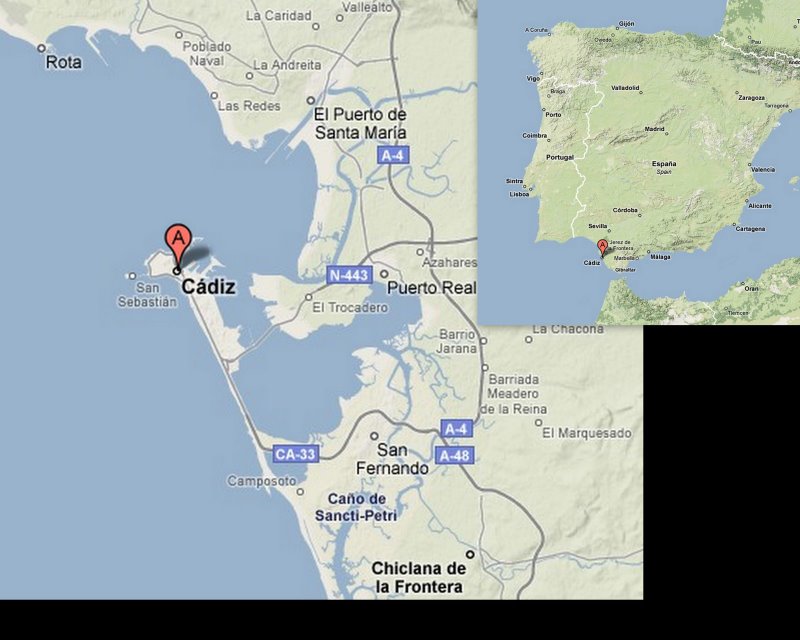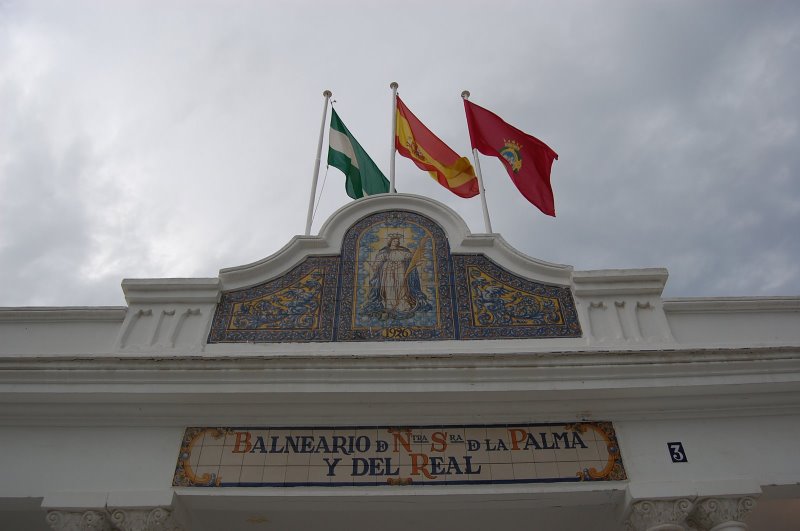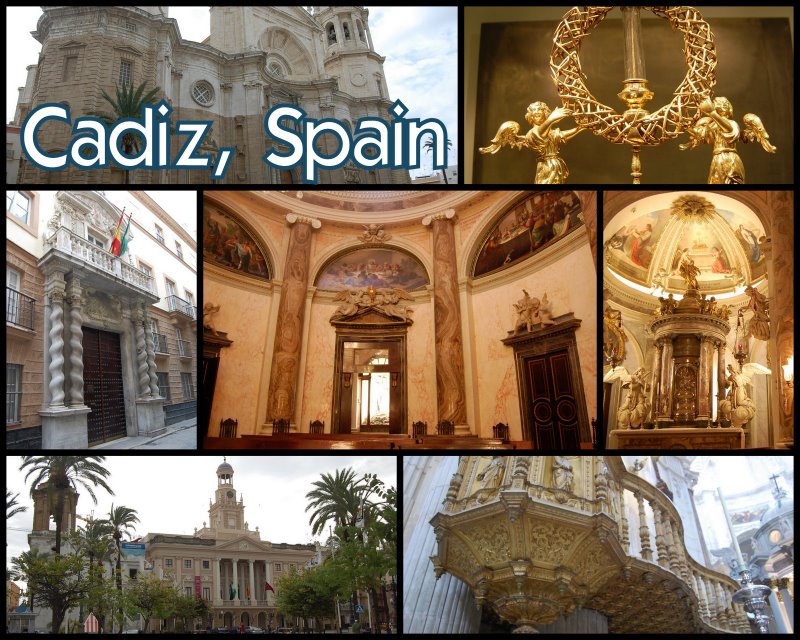The island at the end of the
world
Cadíz's old
city is technically an island but it's connected to the Iberian
Peninsula by a long causeway built on a sandbar. This sandspit creates
a harbor so good that the founding Phoenicians used their word for enclosure to
name the town Gadir and after centuries of sanding by Romans and Arab
tongues we get today’s name: Cadíz.
Many unenlightened Europeans
thought this to be the end of the world until Columbus proved them
wrong. His second expedition left Cadíz in 1493. Contrary to
popular myth today, educated Europeans at that time thought the world
was round -- but small. So small that China and Japan were only a few
weeks sail away if only one knew the right direction.
Founded by Phoenicians
around 1100 BC, Cadíz may be the oldest continuously
inhabited Western city. The Carthaginians took over about 500 BC,
followed by the Romans who made this their 2nd busiest port (after
Ostia which served the city of Rome itself). 
If you had a fleet,
you’d base it in Cadíz as did the Romans and the
Spanish Bourbons. Because its wealth-laden ships were attacked by
pirates, (aren’t we glad those days are over), Spain ran two
protected convoys a year in a combination of merchant and warships
called the Treasure Fleet or West Indies Fleet – which they
headquartered here.
Long before that the
natural harbor attracted commerce and military interest; today over
2500 ships rest pickled in the anaerobic mud that makes the sea around
this town one of the most archeologically rich spots in the
world.
The trade center of the
world
Unfortunately, Cadíz’s sea exposure on 3 sides makes it inviting
to whatever other navy happens to be in the area. With Spain's wealth
and power, many enemies attacked including Barbary Pirates from the
south and the English from the north who all but leveled the place in
1596. Because of Cadíz’s naval exposure and its
distance from the rest of Iberia, the larger city of Seville became the
focal point for Spain’s trade with its huge New World
colonies. Inland Seville was more protected and its long
Guadalquivir River and fertile valley gave it great position for
importing gold and exporting Andalusian products.
But then the
Guadalquivir silted up. So in 1717 the monopoly in the institution of
the La Casa de Contratación (The House of Trade) moved to
Cadíz – and with it the huge wealth that made
merchants rich. In those days, any Spanish colony could trade with only
one European city. Spain was by far the largest empire and
Cadíz was the place for merchants to become rich.
Despite 3 millennia of
Cadíz history, much of the old town appears to be the work
of one very prosperous century: the 18th, when the Casa de
Contratación monopoly funded the rebuilding of a town that
the Brits had leveled a century earlier. By 1790, the Casa was
disbanded. Cadíz never recovered – its loss but
our gain, as monies were not available in future generations to tear
down the beautiful Baroque and neo-classical structures and replace
them with Wal-marts. The old town Cadíz we see is
pretty much what we’d see in 1850.

Forts and walls
After the British wiped
out the place at the end of the 16th century, Cadíz upgraded
its walls and defensive castles. Since then, most of the walls have
been torn down to make room for housing and other developments. But
several of the castles remain.
Fortifications such as pictured above on the Caleta beach started after the Anglo-Dutch fleet destroyed
the place. They were substantially upgraded in the 17th and 18th
centuries when the City became the only port where any of the Spanish
colonies could trade. In those days, Spain then had the greatest empire
in the world -- and Cadíz was booming. If this island-fort
looks familiar to you, it may be that you saw James Bond invade it.
It's really the Castillo de San Sebastián, accessible only
at low tide until the footpath you see in the foreground was added in
the 18th century.
Why would anyone name a
fort after the first Christian martyr (especially one often depicted
with multiple arrows sticking in his torso?) No one did. Long before
this was a fort, the island confined Venetian sailors during a plague
outbreak. They built a chapel to San Sebastian and the name stuck like
arrows in flesh. (Cadíz and Venice were two great trading
cities that got along well; Cadíz eventually copied the
Venetian Mardi Gras festival which is among the best in Iberia today.)
Beach Goddesses
Today the
fortifications are attacked only by tourists and beach structures such
as this modernist building on sticks at Playa de La Caleta were built
for the natives. Does every building in this neo-classical town get a
dome, even the changing rooms on the beach? 
Unfortunately, this
building fell on hard times before being restored in the 1990s. Today
it serves as the headquarters for underwater archeologists -- a busy
group as over 2500 ships have sunk into (and are well preserved by) the
anaerobic mud in Cadíz harbor and bay.
Although the smallest
beach on the island, Caleta is the most popular and witnessed
knife-bearing and bikini-clad Halle Maria Berry emerging ala Ursala
Andress in a 2002 James Bond film where Cadíz impersonated
Havana. (If you’d rather your mythology came from the Greeks
instead of Bond movies, you may argue that Halle rises ala Aphrodite
who wore even less than Ursula did in the 1962 “Dr.
No.” Cadíz, founded within a century of
Troy’s destruction, needs no modern heroes, especially from
the Brits.)

At right is a bit of tile by Justo
Ruiz de Luna honoring our Lady of Palma who greets bathers at La
Caleta's beachhouse. This 1920s reinforced concrete structure replaced
two previous wood buildings, one the Royal Spa (hence the REAL) and the
Palma Spas. Nice of Mary to stop by for naming rights. She was not the
first as the Phoenicians who came around 1100 BC had a temple here to
their virgin and mother goddess Astarte (whom the Greeks renamed
Aphrodite.) Halle, Mary, Astarte, Aphrodite -- this is a beach for
goddesses!
Party on
In Roman days the town,
thought to be at the edge of the world, was a lively harbor for the
Roman fleet and had a bit of a party reputation. It was also known for
its Temple to Hercules who supposedly founded the city. Temples are
still attractions here. Both the old (rebuilt after 1586) and the new
(1722 -- 1838) cathedrals back up to the water on the small island that
holds up the old city of Cadíz. Let’s
visit them on the following page (Please click here).
|
Please join us on the following slide show to give
Cadíz the viewing it deserves by clicking here.
|
|
|
|
Geek and Legal Stuff
Please allow JavaScript to enable word definitions.
This page has been tested in Internet
Explorer 7.0 and Firefox 3.0.
Created on January 15, 2005
|
 |
TIP: DoubleClick
on
any word to see its definition. Warning: you may need to
enable javascript or allow blocked content (for this page only).
TIP: Click on
any picture to see it full size. PC users, push F11 to see
it even larger.
<



